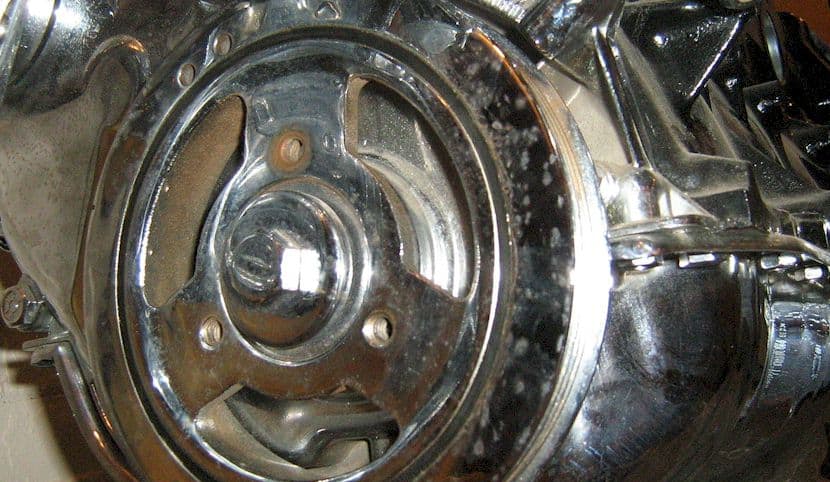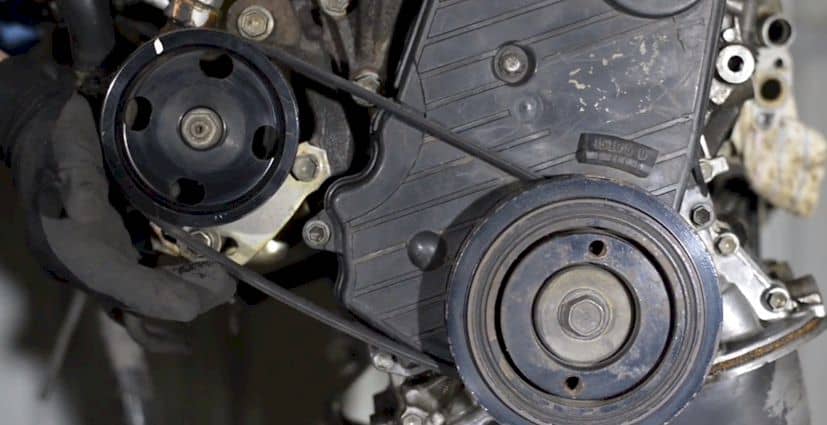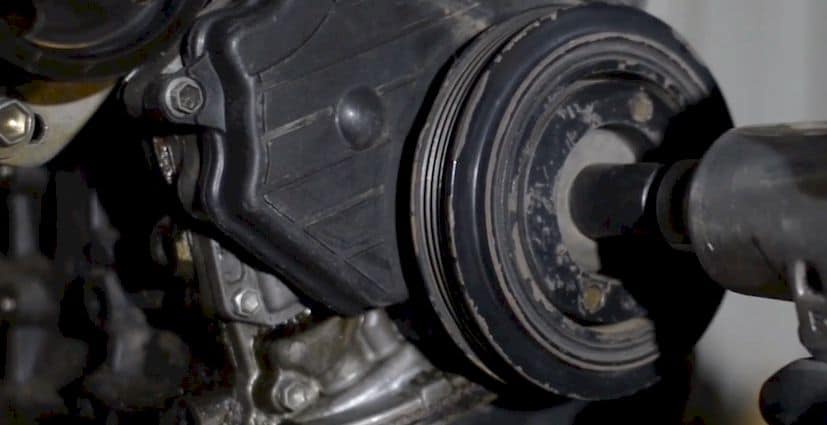The crankshaft pulley/harmonic balancer is a mechanical system that distributes power to other systems of a vehicle. This component is connected to the crankshaft, which is another part that transforms linear motion from the pistons to rotational movement. It is a part that takes engine power to the wheels to move your vehicle. If the crankshaft pulley / harmonic balancer are not working properly, your vehicle will develop the bad symptoms.
What does a crankshaft pulley/harmonic balancer do? You may think that the crankshaft pulley is not as important as other parts of your car’s engine, but actually, it is vital to the proper operation of your vehicle. The crankshaft pulley comes with a harmonic balancer. Just from the name, the crankshaft Pulley/harmonic Balancer is a mediator between pistons and crankshaft. The balancer ensures that energy is transferred in the most efficient and safest way.
Bad Crankshaft Pulley/Harmonic Balancer Symptoms
When a vehicle’s crankshaft Pulley/harmonic Balancer fails, there will be many crankshaft pulley problems that will arise. These signs are easy to distinguish from other car engine troubles. We recommend that you take your car to a licensed, expert mechanic to have it checked as soon as you spot any of these symptoms.
1. Your car engine shakes violently
The most obvious bad crankshaft pulley symptom is a violent shaking of your car engine. This happens because as the crankshaft balancer starts to fail, it will lose its harmonic performance.
Your engine will shake violently and will be most common during high speeds. This is also possible if the crankshaft harmonizer rubber has worn out after an abusive use.
When you continue to overlook the violent shaking, your engine can become too violent, which may eventually explode.
2. Engine timing is disrupted
The harmonic balancer is at the front of the crankshaft pulley and connected to the crankshaft. If there is unequal wear of the crankshaft or the metal and rubber layers slip, timing will be disrupted.
When this happens, the engine will be impossible to time, even as you or a mechanic uses a timing light.
3. The crankshaft pulley/harmonic balancer can slip out of position
As the metal and rubber layers start to wear and tear, the crankshaft harmonic balancer will slip out of position, and you can have a loose crankshaft pulley.
When this happens, the timing will be affected and will soon make the timing belt and similar components to slip off. You won’t be able to drive your car as it will eventually stop moving plus, it will lead to several other mechanical issues.
Also Read: Signs of a bad u joint
4. Very loud noise coming from the engine
One of the crankshaft Pulley/harmonic Balancer failure symptoms is a very loud noise from the engine. When there is engine vibration, there will surely be a lot of loud noises coming from your engine.
The noise will start to pop once you shift to a higher gear.
If the noise becomes louder or is very loud, do not attempt to drive your car. Have a certified mechanic check on it right away.
5. Failing alternator
The alternator will also start to fail since the crankshaft Pulley/harmonic Balancer delivers power to this component. All your lights will start to flicker and will soon shut off completely.
If the damage is too bad, your car may not stay on right after you start the engine up.
6. Failing power steering pump
The power steering pump will also start to fail because the crankshaft Pulley/harmonic Balancer also supplies power to it. This component pumps hydraulic fluid to maintain hydraulic pressure in the steering system.
With a damaged crankshaft pulley, you won’t be able to steer your vehicle easily.
7. Transmission system problems
If the engine vibrates too much, these movements can start to damage the transmission.
The transmission bearings, gears, and input shaft may become damaged due to the intense vibrations, and once these happen, a new set of symptoms will eventually show. You'll have whining noise, leaking transmission fluid, shifting gear problems, and so many more.
Related: Bad input shaft bearing symptoms
What is the role of the harmonic balancer / crankshaft pulley?
This small device reduces your engine’s vibrations. As the cylinders—the power unit of an automobile’s engine—fire, the balancer moves up and down. This generates torque that is transferred to the crankshaft.
The crankshaft, along with the dampener, is responsible for turning the wheels of your car. The forces acting on the rotating rod are tremendous. When a cylinder fires, a certain amount of force in pounds acts upon the crankshaft.

The applied force twists the rotating rod. At specific frequencies, the shaft resonates. This makes the vibrations stronger than usual. When the engine’s vibrations become too much for the crankshaft, it will malfunction. Your engine may not start.
This is when the crank pulley damper comes in. This circular device, made of rubber and metal, is attached with bolts at the front of the crankshaft. It absorbs vibrations as the shaft rotates. Hence, the name “dampener,” the harmonic balancer prevents crankshaft failure.
Still, the rubber material deteriorates as time passes by. This is the reason why you’re getting rough vibrations when the rubbery device is going bad.
The serpentine belt of your auto may also get casted away. Replacing a bad dampener prevents maintenance and costly repairs. It’s cheaper than the crankshaft and the serpentine belt. ( The serpentine belt replacement Cost )
Without the dampener, your vehicle will need constant repairs. And it will not run smoothly. Your engine may not start as well. The dampener is composed of two elements: the mass and energy-dissipating element. Together, they get rid of and balancer out vibrations.
When torque is applied on the crankshaft, it’s in sync with the engine’s cylinders. As such, resonance is created.
Other than engine vibrations, the generated sound also affects the dampener. If a malfunctioning harmonic balancer is installed, too much stress is applied to the crankshaft.
If this continues, your auto will not start due to a cracked crankshaft. As mentioned in the introduction, the elements absorb and resist the vibrations’ acceleration. Hence, the crankshaft pulley/harmonic balancer is an integral part of your car’s engine.
Read Next: Bad Transmission Control Module Symptoms
Can You Drive With A Bad Crankshaft Pulley/Harmonic Balancer?
No, you cannot drive with a bad crankshaft pulley / harmonic balancer. If you ignore these symptoms, your engine will soon fail, and you won’t be able to drive your car, let alone start it. Usually, you will only experience very mild symptoms like mild noises from the engine, which oftentimes are overlooked by car owners.
This is why, as soon as you hear any “unusual” sounds from your engine along with sudden and intense vibrations, you should have a car mechanic check your vehicle out.
When Should I Replace Crankshaft Pulley/ Harmonic Balancer and Replacement Cost?
You should have your car checked the moment you experience any of these symptoms. A professional car engine specialist will tell you if there is a component to be replaced, or you need a complete replacement of your crankshaft harmonic balancer. This engine part is usually made from scratch, and you can’t control its wear and tear.
A crankshaft pulley/harmonic balancer replacement cost may be anywhere from $100 to $400. The more pricey or rare your car brand is, the more expensive this component will be. The crankshaft pulley/harmonic balancer replacement cost may also vary depending on where you take it. Labor costs may vary, starting from $100 to $300.
The key to preventing costly crankshaft pulley/harmonic balancer replacement and repairs is to have your vehicle checked at least once a year by a certified car mechanic. This becomes more important if you have an older vehicle. A mechanic can check for early signs of wear and tear.
If your vehicle is no longer drivable, a certified mechanic can inspect your car at your home or your office.
Related Post: https://curateview.com/bad-ball-joint-symptoms/
How to Remove Crankshaft Pulley/Harmonic Balancer Plus Installation Instructions
Before you start, prepare the following tools:
- A balancer puller
- A carburetor cleaner
- An installation toolkit
- A pair of pliers
- Two wrenches
- An impact wrench
You can use fine sandpaper if you don’t have a carburetor cleaner. When you have the tools above, you can start removing the device.
1): Gently pull out the serpentine belt to gain access to the harmonic balancer.

2): Second, remove the bolt at the center with a wrench or pliers. The center bolt supports the dampener. It’s usually very tight.

3): Remove the equipped pulley.
4): Now, you must evenly install the balancer puller. Wind the bolts to a far distance so that they won’t be pulled out by the puller.

5): With an impact wrench, tighten the pulley. When you hear “pop,” the damper is beginning to be removed from the crankshaft.
6): When the harmonic balancer is removed, use a carburetor cleaner or sandpaper to clean the crankshaft. Always do this before installing a new dampener.
7): The installation kit is for installing the new device. At this step, never hammer the harmonic balancer into the engine. Next, heat the device to 160 degrees Celsius to expand it. This makes the installation process easy.
8): For this step, align the balancer woodruff with the use of the keyway on the crankshaft. Then, set the device into position. After that, start winding the installation kit in place.
9): Using 2 wrenches, tighten the kit properly. Then, apply sealer on the center bolt and begin installing. According to the manufacturer’s specification, tighten the remaining bolts.
You have just installed the new crankshaft pulley / harmonic balance. To finish, you have to reinstall the serpentine belt.
Final Words

The crankshaft pulley / harmonic balancer is found in all engines. This component helps protect your car’s engine from vibrations and damage. If you think that your car has bad crankshaft pulley / harmonic balancer symptoms, have it checked by a professional car technician as soon as possible. A technician will determine if you need a crankshaft pulley replacement.
Also Installing and removing it is fairly easy. Just prepare the right tools, and ready your new device. To remove crankshaft pulley/harmonic balancer, do follow the steps above, and everything will be fine.
Resources:
https://www.supercheapauto.com.au/blog/how-to/servicing-and-mechanical/removing-a-harmonic-balancer.html
https://en.wikipedia.org/wiki/Harmonic_damper
https://auto.howstuffworks.com/engine.htm
Simon graduated with a Mechanical and Electrical Engineering Degree. He has over 20 years of servicing experience in both Japanese and German car dealerships. He now acts as a freelance mechanic’s instructor for local schools.
